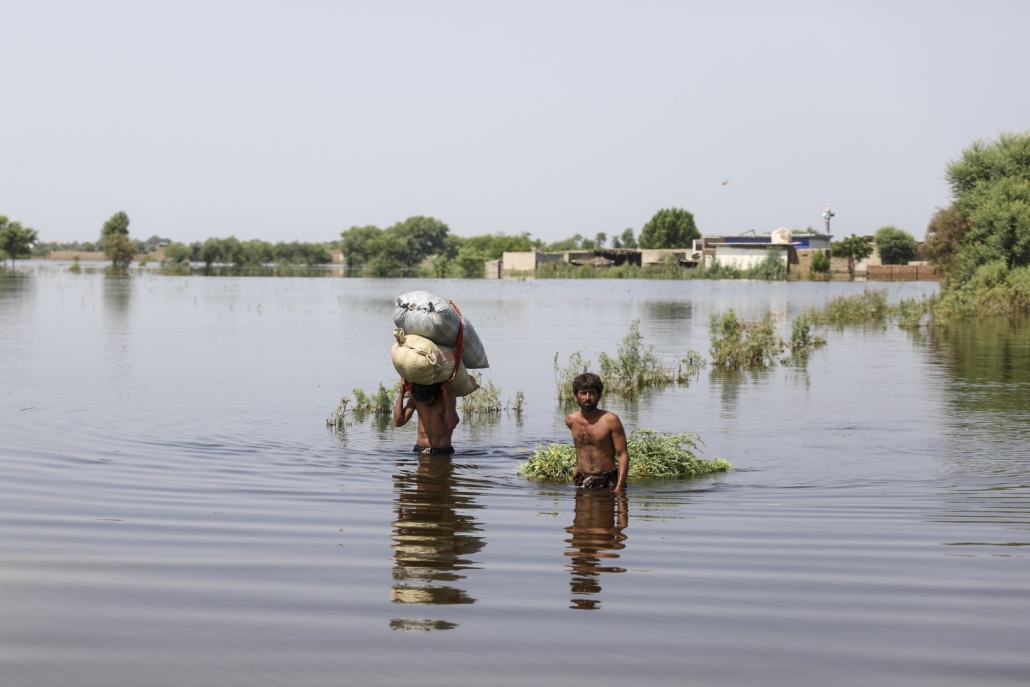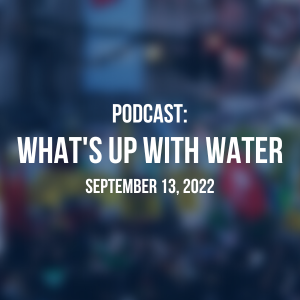Monsoon rains arrive as the country battles a financial crisis.

Floodwaters reach waist-high in the Malook Khaskhali village in Sindh province. Photo © UNICEF/Asad Zaidi
By Laura Gersony, Circle of Blue—September 12, 2022
Months after Pakistan baked under a record-setting heat wave, relentless monsoon rains are the latest threat to a climate-vulnerable country that is reeling from disaster after disaster.
Abounding rainfall in recent weeks is only one part of the peril. With damages exceeding tens of billions of dollars, flooding has affected one in seven Pakistanis. Some 630,000 people have been displaced, and 1,300 have died — hundreds of them children.
The scale of loss would have been devastating anywhere. But recovery will be all the more difficult for the world’s fifth-most populous country because of a second group of factors. A year of financial and political crises have left Pakistan’s economy on a knife-edge.
“Pakistan, which is already facing political and economic turmoil, has been thrown into the front line of the human-induced climate crisis,” a U.N. statement read earlier this week.
Climate scientists forecast with medium confidence that continued atmospheric warming will cause more erratic and powerful monsoons in South Asia.
That was the case this monsoon season, when Pakistan received eight rounds of heavy rain, about twice as many as usual. The rains, which were bad enough, were made worse by above-average glacial melt from northern mountains.
Aid groups say all signs point to food shortages. A U.N. humanitarian agency estimates that at least 3.6 million acres of crops and orchards across the country have been affected by floodwaters. In the hard-hit agricultural province of Sindh, this season’s cotton production is down by 45 percent, dates by 85 percent, and rice by 31 percent.
The conditions could spill over into neighboring Afghanistan, where half of the population faces acute hunger. Much of the U.N.’s food assistance for Afghanistan is transported by road through Pakistan.
“The floods in Pakistan are going to put a huge dent in that capability and a greater reliance on imported food and commodities,” Chris Kaye, director of the U.N. World Food Program in Pakistan, told VOA News. “We are becoming very, very concerned about the overall food security.”
The government has plans to buy 200,000 tents for displaced families, officials say, and has dispersed $300 million in cash handouts. The U.N. has called for $150 million in international support.
A fuller response that addresses damages to personal assets and national infrastructure will require much more: estimates range from $10 billion to $30 billion, a price tag that will strain the country’s economic recovery during a politically unsettled period.
Pakistan was “inches away” from civil unrest and financial collapse just months ago, when voters ousted former Prime Minister Imran Khan, the polarizing leader whose dual gripes – of corruption in Pakistan and Western political influence – propelled him to power in 2018. A $6 billion financing program from the International Monetary Fund had stalled under Khan, as the prime minister’s loose monetary policy and dwindling foreign exchange reserves made Pakistan ineligible for IMF loans.
Khan’s successor, Shebhaz Sharif, implemented the painful austerity measures required by the IMF to resume the loan program. The measure has had punishing consequences for residents already grappling with double-digit inflation. According to government figures, virtually every consumer price index continues to climb. The inflation rate was 27 percent last month.
Laura Gersony covers water policy, infrastructure, and energy for Circle of Blue. She also writes FRESH, Circle of Blue’s biweekly digest of Great Lakes policy news, and HotSpots H2O, a monthly column about the regions and populations most at-risk for water-related hazards and conflict. She is an Environmental Studies and Political Science major at the University of Chicago and an avid Lake Michigan swimmer.





